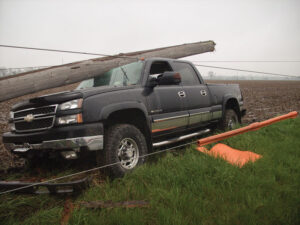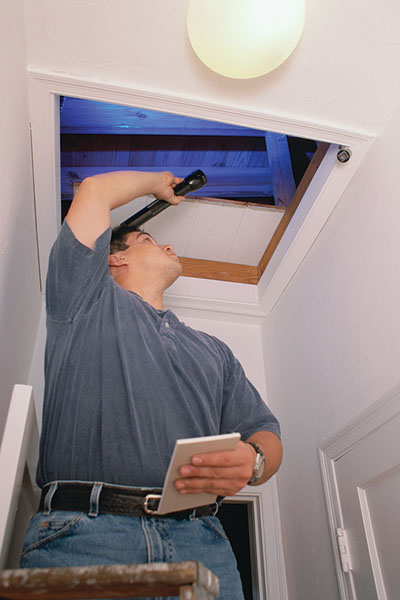
On Sat. April 27, 2013, at 3:30 p.m., Rural Electric Convenience Cooperative linemen Bill Hart and Curt Nichelson responded to a report of a pole being hit and electric lines on the ground near Litchfield, Ill. When they arrived, they found a broken transmission pole and a pickup that had been energized. Fortunately, Mathew Emery, the driver, didn’t panic and knew the crackling sound of electricity meant he should stay in the cab until help arrived.
Emery, who had lost control on the rain slick road, said, “I was safer in there than I was outside. People who saw the accident were sitting on the road talking to me, and I knew the best thing for me to do was stay put.”
This wasn’t just an ordinary distribution line on top of his truck. It was a 34,500-volt Ameren transmission line. The co-op’s 7,200-volt distribution line was attached to the pole under the transmission line and was now suspended about three feet above the ground just outside of the driver’s door.
The Ameren lineman on the scene said that you could hear the vehicle “sizzling” with electricity. He disconnected the energized electric lines and used his bucket to lay insulated blankets on the ground and sleeves on the phase, to safely remove the driver.
In traumatic situations like this every instinct tells you to flee as you try to control the fear and panic. However, if you are in a car accident with a power line, the safest place is often inside the car. To survive you have to stop and think. Electricity is always seeking a path to ground. If you become part of that path by stepping out of the vehicle the results could be instantly fatal.
Only in the rare instance of fire should you exit the vehicle. Then, you must know how to do so safely, jumping free and clear of the vehicle, landing with feet together and hopping away. It’s difficult to get out without creating a path for current to flow, and doing the bunny hop may seem strange, and this is why you should get out only if absolutely necessary.
Two Indiana teenagers, Ashley Taylor and Lee Whitaker, experienced such a traumatic situation themselves in 2009 when they were in an auto accident involving power lines. Fortunately, earlier that week they had attended a program sponsored by their local electric cooperative at their school that warned of the dangers of car accidents with power poles. Lee and Ashley made sure nobody left the car and warned those who came upon the accident to stay far away.
Lee and Ashley are grateful to the Indiana cooperative, White County REMC, and the Safe Electricity partner that sponsored Illinois native and former lineman Kyle Finley, and his Live Line Demo program at their school.
It’s also important to warn those who come upon such an accident to stay away, as approaching an accident scene involving power lines can be deadly. That was the case when a Good Samaritan approached a wrecked car near Jacksonville, Fla., and was electrocuted when he stepped over a downed wire. The 52-year-old man attempted to assist a motorist whose car swerved to avoid hitting a deer and collided with a utility pole holding an electric line. The motorist was seeking help to be freed from the car when the tragedy occurred.
When people are involved in this type of car accident, electricity is usually the last thing on anyone’s mind. We’re often more concerned about whether anyone was injured, or how badly the vehicle is damaged. Remember, don’t panic and stay put. And please share these safety stories with those you love and go to www.safeelectricity.org for more.
Molly Hall is Director of Safe Electricity. E-mail molly-hall@SafeElectricity.org. Safe Electricity is a public awareness program of the Energy Education Council. www.EnergyEdCouncil.org








